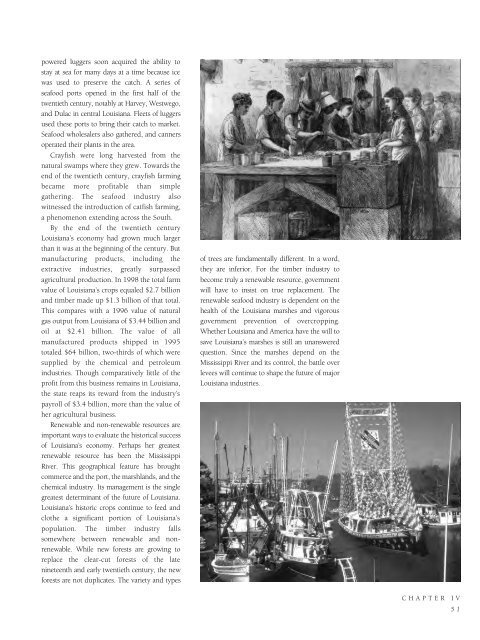Historic Louisiana
An illustrated history of Louisiana, paired with the histories of companies, families and organizations that make the state great.
An illustrated history of Louisiana, paired with the histories of companies, families and organizations that make the state great.
Create successful ePaper yourself
Turn your PDF publications into a flip-book with our unique Google optimized e-Paper software.
powered luggers soon acquired the ability to<br />
stay at sea for many days at a time because ice<br />
was used to preserve the catch. A series of<br />
seafood ports opened in the first half of the<br />
twentieth century, notably at Harvey, Westwego,<br />
and Dulac in central <strong>Louisiana</strong>. Fleets of luggers<br />
used these ports to bring their catch to market.<br />
Seafood wholesalers also gathered, and canners<br />
operated their plants in the area.<br />
Crayfish were long harvested from the<br />
natural swamps where they grew. Towards the<br />
end of the twentieth century, crayfish farming<br />
became more profitable than simple<br />
gathering. The seafood industry also<br />
witnessed the introduction of catfish farming,<br />
a phenomenon extending across the South.<br />
By the end of the twentieth century<br />
<strong>Louisiana</strong>’s economy had grown much larger<br />
than it was at the beginning of the century. But<br />
manufacturing products, including the<br />
extractive industries, greatly surpassed<br />
agricultural production. In 1998 the total farm<br />
value of <strong>Louisiana</strong>’s crops equaled $2.7 billion<br />
and timber made up $1.3 billion of that total.<br />
This compares with a 1996 value of natural<br />
gas output from <strong>Louisiana</strong> of $3.44 billion and<br />
oil at $2.41 billion. The value of all<br />
manufactured products shipped in 1995<br />
totaled $64 billion, two-thirds of which were<br />
supplied by the chemical and petroleum<br />
industries. Though comparatively little of the<br />
profit from this business remains in <strong>Louisiana</strong>,<br />
the state reaps its reward from the industry’s<br />
payroll of $3.4 billion, more than the value of<br />
her agricultural business.<br />
Renewable and non-renewable resources are<br />
important ways to evaluate the historical success<br />
of <strong>Louisiana</strong>’s economy. Perhaps her greatest<br />
renewable resource has been the Mississippi<br />
River. This geographical feature has brought<br />
commerce and the port, the marshlands, and the<br />
chemical industry. Its management is the single<br />
greatest determinant of the future of <strong>Louisiana</strong>.<br />
<strong>Louisiana</strong>’s historic crops continue to feed and<br />
clothe a significant portion of <strong>Louisiana</strong>’s<br />
population. The timber industry falls<br />
somewhere between renewable and nonrenewable.<br />
While new forests are growing to<br />
replace the clear-cut forests of the late<br />
nineteenth and early twentieth century, the new<br />
forests are not duplicates. The variety and types<br />
of trees are fundamentally different. In a word,<br />
they are inferior. For the timber industry to<br />
become truly a renewable resource, government<br />
will have to insist on true replacement. The<br />
renewable seafood industry is dependent on the<br />
health of the <strong>Louisiana</strong> marshes and vigorous<br />
government prevention of overcropping.<br />
Whether <strong>Louisiana</strong> and America have the will to<br />
save <strong>Louisiana</strong>’s marshes is still an unanswered<br />
question. Since the marshes depend on the<br />
Mississippi River and its control, the battle over<br />
levees will continue to shape the future of major<br />
<strong>Louisiana</strong> industries.<br />
CHAPTER IV<br />
51
















